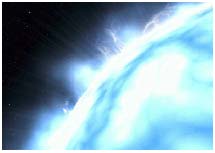 A team of researchers composed of astrophysicists from Québec, and led by Patrick Dufour, postdoctoral research at the Université de Montréal (UdeM) and member of the CRAQ, analyzed data recently obtained from the Hubble Space Telescope with its new instrument, the Cosmic Origin Spectrograph (COS). The work of the researchers (from the UdeM, the University of Colorado, and the Space Telescope Institute in Baltimore), confirmed the luminosity variations of three stars already observed with ground telescopes. They also discovered a new member of the pulsating white dwarf subgroup, for the first time with observations from space. A team of researchers composed of astrophysicists from Québec, and led by Patrick Dufour, postdoctoral research at the Université de Montréal (UdeM) and member of the CRAQ, analyzed data recently obtained from the Hubble Space Telescope with its new instrument, the Cosmic Origin Spectrograph (COS). The work of the researchers (from the UdeM, the University of Colorado, and the Space Telescope Institute in Baltimore), confirmed the luminosity variations of three stars already observed with ground telescopes. They also discovered a new member of the pulsating white dwarf subgroup, for the first time with observations from space.
White dwarfs are "dead" stars which core does not produce energy via thermonuclear reactions anymore. They are very compact astronomical objects with surface gravitational fields more than 100,000 larger than that of the Earth. The heaviest chemical elements (like carbon, magnesium, iron, etc…) are sinking toward the center of the star, while lighter elements like hydrogen and helium will "float" on the surface. This is why most of the white dwarfs we observed have atmospheres exclusively composed of hydrogen and/or helium.
However, in 2007, a new class of white dwarf was discovered: the carbon-atmosphere white dwarfs. For reasons that are not fully understood at the moment, this type of white dwarfs lacks hydrogen and helium and they have atmospheres almost exclusively composed of carbon.
In order to shed light on the formation mechanism of these stars, observations with the Hubble Space Telescope were obtained for five of these very rare objects (14 are known at the moment). With the observations, the research group led by Patrick Dufour demonstrated the presence of periodical luminosity variations of a few percent, in four of these targeted white dwarfs.
A more detailed asterosismology analysis of the luminosity variations, which carry information on the internal structure of the object, will eventually permit to understand the formation and the evolution of these mysterious objects. The astronomers are suspecting that they could be among the most massive white dwarfs. In other words, they are the remnants of stars that are a little bit too small to explode into supernovae, which would leave a black hole or a neutron star).
The work will be published in the prestigious "Astrophysical Journal Letters", in May.
The image above is an artistic representation of a carbon-atmosphere white dwarf. They emit ultraviolet light and in the blue part of the visible light spectrum.
link to article : http://arxiv.org/abs/1104.2543
Source :
Patrick Dufour, Ph. D.
Département de physique, Université de Montréal
Centre de recherche en astrophysique du Québec
Phone: (514) 343 6111 poste 7077
dufourpa@astro.umontreal.ca
Informations :
Olivier Hernandez
Responsable des relations avec les médias
Centre de recherche en astrophysique du Québec
Phone: (514) 343 6111 poste 4681
olivier@astro.umontreal.ca
|

 A team of researchers composed of astrophysicists from Québec, and led by Patrick Dufour, postdoctoral research at the Université de Montréal (UdeM) and member of the CRAQ, analyzed data recently obtained from the Hubble Space Telescope with its new instrument, the Cosmic Origin Spectrograph (COS). The work of the researchers (from the UdeM, the University of Colorado, and the Space Telescope Institute in Baltimore), confirmed the luminosity variations of three stars already observed with ground telescopes. They also discovered a new member of the pulsating white dwarf subgroup, for the first time with observations from space.
A team of researchers composed of astrophysicists from Québec, and led by Patrick Dufour, postdoctoral research at the Université de Montréal (UdeM) and member of the CRAQ, analyzed data recently obtained from the Hubble Space Telescope with its new instrument, the Cosmic Origin Spectrograph (COS). The work of the researchers (from the UdeM, the University of Colorado, and the Space Telescope Institute in Baltimore), confirmed the luminosity variations of three stars already observed with ground telescopes. They also discovered a new member of the pulsating white dwarf subgroup, for the first time with observations from space.